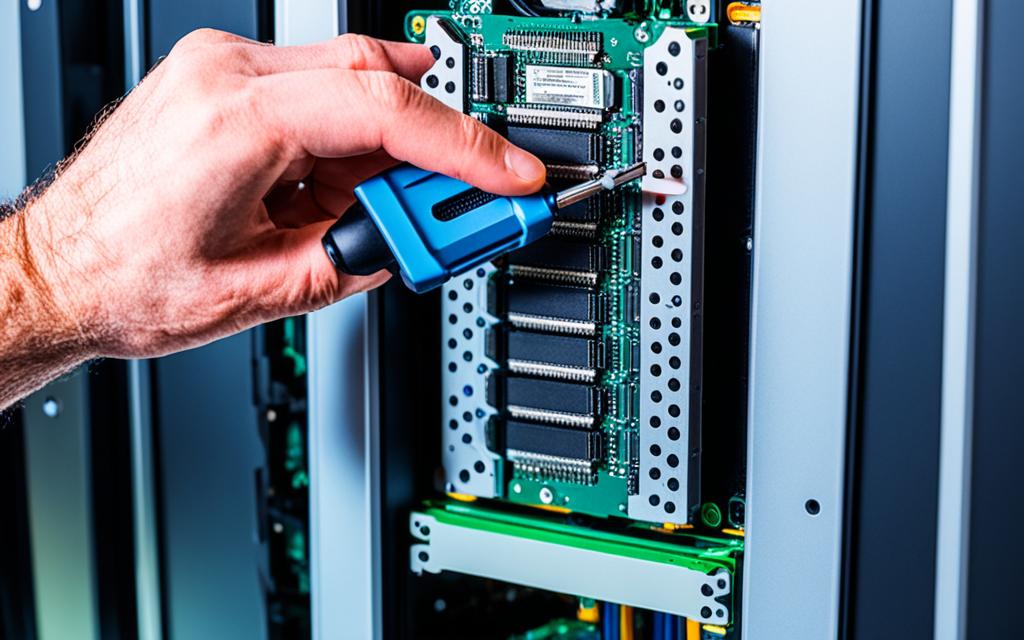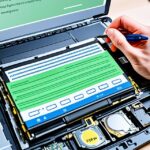Table of Contents
Taking the operating system (OS) off a hard drive might feel challenging, but it’s something many need to do. They might want to upgrade, free up space, or get ready for a new system. Knowing what this step means is crucial, especially when it comes to safeguarding your data and keeping your system working well. Currently, Windows is the top choice1for many around the world, who look for advice on removing parts of the OS from their drives2.
With the right directions and tools, you can ease the hassle of managing your data. This sets you up for a clean slate with an old hard drive. Our guide is here to give you the confidence to tidy up your system or switch to a new one smoothly.
Key Takeaways
- Removing the OS can free up valuable space on your hard drive.
- It is important to back up critical data before commencing the removal process.
- Tools like DiskPart and user-friendly partition managers can streamline the OS removal.
- Understanding the removal process is essential for smooth transitions to new systems.
- Data protection must be a priority during any deletion or removal procedure.
Understanding the Need to Remove the OS
There are various reasons why removing the OS is needed. It includes both practical reasons and specific situations. People want to free up space on their hard drives. This is vital when working with limited space.
By doing so, they can improve their system’s available memory. It also boosts the system’s overall performance significantly.
Benefits of Removing the OS
One key advantage of this process is being able to upgrade. You can move to a newer OS or a solid-state drive (SSD). Upgrading from Windows 8.1 to Windows 7 on an SSD, for example, enhances speed and responsiveness. Also, removing unneeded files and folders makes for a tidier, more efficient system3.
Scenarios When You Might Need to Remove the OS
Sometimes, removing an OS becomes a must. This is especially true for those who’ve moved files to a new SSD of less than 60GB. In such cases, the old OS is redundant. Another scenario is repurposing old drives, which involves clearing old systems for new uses.
Tools like EaseUS Data Recovery Wizard Pro can help, especially in recovering lost important files3. For more tips on keeping your PC in top shape and lasting longer, check out this comprehensive guide.
Preparing for the Removal Process
Getting ready to remove an operating system from your hard drive is important. First, make sure to back up your data well. Using tools like EaseUS Data Recovery Wizard Pro keeps your files safe. Not backing up can mean losing important data if errors happen during OS removal.
Creating Backups to Protect Your Data
Start by saving your important data safely. It helps to use both cloud storage and external hard drives. A good plan minimises the risk of losing any data. Keep a record of what you’ve backed up for later use.
Tools You Will Need for the Process
Choosing the right tools can make things easier. Diskpart helps manage parts of your drive. Easy-to-use partition managers are great for those who don’t like using codes. Tools like Disk Wipe and AOMEIt; Partition Assistant keep your info safe when getting rid of your computer. Knowing these tools helps make the process smoother.
For detailed advice on getting your computer ready to throw away, visit: how to prepare your computer for4.
How to Remove the OS from a Hard Drive
To remove the operating system from your hard drive, use Diskpart. It lets you manage partitions and delete the OS. At the same time, it keeps your important data safe.
Steps to Remove Windows Using Diskpart
Start by opening the Command Prompt as an administrator. Follow these steps closely:
- Type diskpart and press Enter to open Diskpart.
- Use the command list disk to see all disks.
- Choose your disk with select disk X, X being your disk number.
- To see partitions, type list partition.
- Pick the partition to delete with select partition Y, Y is the partition number.
- Delete the selected partition by using delete partition.
Diskpart is useful for precise tasks without needing extra software. It’s a fast way to remove the OS using Diskpart.
Advantages of Using Diskpart for OS Removal
Diskpart is simple, allowing easy command executions. It’s quicker than using graphical interfaces. Diskpart’s accuracy helps experienced users manage drives well, without needing other software. It’s a top choice for tackling the challenge of OS removal.
Overall, Diskpart makes removing the operating system easier. It gives users more control over hard drives and teaches disk management skills5.
Alternative Methods for OS Removal
Looking for an easy way to remove an operating system? Alternative OS removal methods offer a simpler solution. A partition manager that’s easy to use can make things much easier. This is especially true for those not used to working with complex command lines.
Using a User-Friendly Partition Manager
A partition manager like AOMEI Partition Assistant makes deleting OS partitions smooth. Its design is straightforward, allowing you to easily choose which partitions to erase. This method avoids complex commands, making it perfect for all levels of experience.
Third-Party Software for OS Removal
Besides partition managers, there are also third-party software options that offer more flexibility. These tools let you safely get rid of an operating system while keeping the rest of your data safe. There’s a variety out there, so both beginners and pros can find something that works for them.
| Method | Description | Advantages |
|---|---|---|
| Partition Manager | Software that allows users to manage partitions easily | User-friendly interface, no complex commands required |
| Third-Party Software | Specialised tools for secure OS removal | Flexibility and extra features to assist users |
These methods can save time and give you more control over your data. Explore the options to find what best fits your needs6.
Steps to Remove OS from an Old HDD
When you’re dealing with an old hard drive, start with a system file cleanup. It makes sure that removing the OS from the old HDD goes smoothly and quickly.
Clean Up System Files Before Removal
Start by cleaning up system files before you remove the OS. This step makes your computer run better and makes it easier to delete the operating system. Getting rid of unnecessary files helps simplify your system.
This makes the OS removal easier. This also cuts down on clutter, helping the removal to go on without any issues.
Using Disk Cleanup to Free Up Space
Using the Disk Cleanup tool is a smart way to free up space on your old HDD. Disk Cleanup gets rid of temporary files and unneeded data. This makes more room and helps with effective old HDD OS removal. Here’s how to use Disk Cleanup:
- Open the Start menu and search for “Disk Cleanup.”
- Select the drive you wish to clean up.
- Choose the file types to remove, like temporary internet files and thumbnails.
- Press “OK” to begin the cleanup.
This approach makes the removal process smoother. It prepares your hard drive for any new use73.
Considerations After OS Removal
After you remove the operating system, it’s important to think about the next steps. This ensures your hard drive works well. Start by checking your data to find valuable files. Deciding which files to keep or get rid of helps use your space better.
Evaluating the Remaining Data on the Drive
Removing the OS requires you to look at what data is left. This check helps decide what to keep and back up. It’s a chance to delete files you don’t need, boosting your system’s performance and readying the drive for future use.
Partitioning the Hard Drive for Future Use
Partitioning your drive is a key step after OS removal. It makes managing your data and running your system smoother. By setting up specific areas for different data types, accessing what you need gets easier. This setup is great for organizing backups, system files, and personal stuff.
Thinking about these steps post-OS removal can really make your hard drive serve you better. Proper data checks and smart partitioning are crucial. They bring about big improvements in how your drive functions8.
Possible Issues During the Removal Process
Users often face issues when removing an OS that can slow them down. Knowing these mistakes can make fixing problems easier. This makes changing systems smoother.
Understanding Common Errors
One big mistake is using commands wrongly with tools like Diskpart. This can stop the process, leading to annoyance. Also, systems may not detect external drives correctly. Understanding these errors helps users be more confident and successful.
Troubleshooting Diskpart Command Issues
To fix Diskpart issues, start by making sure commands match the drive correctly. Mistakes here can cause big problems. If things are still unclear, check the command’s guide for help. Using tools like EaseUS Partition Master can make things easier. These tips and tools boost confidence in handling OS removal challenges910.
Conclusion
Removing an OS from a hard drive is key to keeping your data safe and boosting your system’s performance. Knowing the available methods, including DoYourData Super Eraser, lets you choose the best way for you. A detailed process review stresses the need to back up your data for a smooth OS removal.
It’s important to know that simply deleting files doesn’t fully erase them. Surprisingly, only 40% of people know this fact11. So, using proper erasure methods is crucial to stop the recovery of private data. This keeps your information safe before you sell or change the use of your drive.
Starting the OS removal with good planning helps to successfully complete it and allows for upgrading or reusing old drives. Focusing on data security both before and after removal is at the heart of responsible computer use. It leads to a more effective and secure tech world.
FAQ
What precautions should I take before removing the OS from my hard drive?
Before taking out the OS, make sure to back up all key data. This stops you from losing it by accident. EaseUS Data Recovery Wizard Pro can be a big help if things go wrong.
How can I reclaim space on my old hard drive?
To get back space, start by deleting the old OS and tidying up system files. Use the Disk Cleanup tool to remove unneeded files and error reports. This step frees up more space for you.
Is it safe to use Diskpart for OS removal?
Yes, for those who know stuff about computers, using Diskpart is mostly safe. It lets you manage your hard drive with a lot of details. But, be careful not to erase the wrong section.
What if I am not comfortable using command-line tools?
If command-line tools like Diskpart scare you, try easier ones like AOMEI Partition Assistant. They make getting rid of the OS simple, without needing tricky commands.
What types of errors might I encounter while removing an OS?
When removing an OS, you might use a command wrong, not find your drive, or hit problems with system files. Learning about these issues helps you fix them faster and makes the process smoother.
How do I evaluate the data left on my hard drive after OS removal?
Look through the data left after the OS is gone. Decide what to keep, back up, or throw away. This step is key to knowing what space you have for new stuff.
Source Links
- https://www.smartwebsolutions.org/blog/how-to-remove-windows-os-from-another-drive-without-formatting/ – How to remove windows OS from another drive without formatting
- https://www.diskpart.com/articles/how-to-remove-windows-from-old-hdd-1984.html – 2 Methods to Remove Windows 10, 8, 7 from Old HDD?
- https://www.easeus.com/questions/recovery/delete-os-from-hard-drive-but-keep-data.html – How to Delete the OS from a Hard Drive but Keep the Data
- https://www.pcmag.com/how-to/how-to-properly-prep-your-pc-for-disposal – Ready to Recycle? How to Properly Prepare Your PC for Disposal
- https://www.dell.com/support/kbdoc/en-us/000122450/replacing-the-hard-drive-on-a-dell-portable-system – How to Replace a Dell Laptop Hard Drive: Step-by-Step Guide
- https://windowsreport.com/remove-os-but-keep-files/ – How to Remove Windows From a Drive but Keep Your Data
- https://www.acronis.com/en-gb/blog/posts/how-to-move-os-to-another-drive/ – How To Move OS To Another Drive – Complete Guide & Software
- https://forums.tomshardware.com/threads/how-to-remove-os-from-old-hdd.3067070/ – How to remove OS from old HDD?
- https://www.easeus.com/partition-manager-software/does-formatting-remove-os.html – Does Formatting a Hard Drive Remove OS? Check Your Full Guide Here 2024
- https://www.partitionwizard.com/disk-recovery/remove-files-and-clean-the-drive.html – Reset Windows 10: Remove Files and Clean the Drive – MiniTool Partition Wizard
- https://www.diskgenius.com/how-to/how-to-completely-wipe-a-hard-drive.php – 3 Methods to Completely Wipe Hard Drive in Windows 10/8/7/XP








